Hyper-V Failover Cluster Backup
Backup for Windows VM edition supports Microsoft Hyper-V Failover Cluster backup and restore. Hyper-V cluster backup is available in the new backup format only.
For now, Backup for Windows VM Edition supports only local Failover Cluster backup. This means that the Backup for Windows instance must be installed on the Hyper-V host with a Failover Cluster to be backed up. As a minimum requirement, the backup user should be a member of the following groups on every Hyper-V cluster node: the "Domain Users" group and the local "Administrators" group.
About Hyper-V Failover Cluster
| Component | Requirement |
|---|---|
| Operating System | Windows Server 2008 R2/2012/2012 R2/2016/2019 with Hyper-V role |
| MSP360 (CloudBerry) Backup | VM Edition |
This chapter cover the following topics:
Create Backup Plan
To create a new Hyper-V backup plan, click the Hyper-V action in the horizontal menu bar and select Hyper-V Backup. To use legacy Hyper-V backup, select Hyper-V Backup (Legacy).

The Create Hyper-V Backup Plan Wizard starts.
Learn Backup Wizard steps:
- Select Backup Storage
- Plan Name
- Advanced Options
- Connect to a Hyper-V Cluster
- Select Virtual Machines
- Select Virtual Disks
- Compression and Encryption Options
- Consistency Check and Restore Verification
- Schedule
- Retention Policy
- Pre / Post Actions
- Notifications and Logging
- Summary
Select Backup Storage
Select a storage account for the backup plan from the list of available backup storages. If no storage is available, click Add new Storage Account. You can select any of the supported backup storages. Check whether you have enough free storage capacity for backup. Once you selected backup storage, click Next.
Plan Name
Specify the name for the backup plan.
Click Next.
| Previous Step | Top | Next Step |
Advanced Options
Select advanced settings for the backup plan:

- Select the Use synthetic full backup checkbox to enable the synthetic full backup, or clear the checkbox to disable.
Amazon S3 Storage Classes

If your backup storage destination is Amazon S3, select the S3 storage class for the backup plan:
- Standard
- Intelligent-Tiering
- Standard-IA
- One Zone-IA
- Glacier Instant Retrieval
- Glacier Flexible Retrieval (formerly S3 Glacier)
- Glacier Deep Archive
Usage of different storage classes for different backups is the subject of optimizing your storage costs.
Learn more about Amazon S3 storage classes here
Microsoft Azure Blob Storage
If your backup storage destination is Microsoft Azure, and you have the General Purpose v2 Azure account, select the required Azure Blob Storage.

The following options are available:
- Hot tier. An online tier optimized for storing data that is accessed or modified frequently. The hot tier has the highest storage costs, but the lowest access costs.
- Cool tier. An online tier optimized for storing data that is infrequently accessed or modified. Data in the cool tier should be stored for a minimum of 30 days. The cool tier has lower storage costs and higher access costs compared to the hot tier.
- Cold tier.An online tier optimized for storing data that is rarely accessed or modified, but still requires fast retrieval. Data in the cold tier should be stored for a minimum of 90 days. The cold tier has lower storage costs and higher access costs compared to the cool tier.
- Archive tier. An offline tier optimized for storing data that is rarely accessed, and that has flexible latency requirements, on the order of hours. Data in the archive tier should be stored for a minimum of 180 days.
Note that this feature is only supported for General Purpose v2 Azure accounts. If you are using another kind of account, you need to upgrade your account to be able to use this feature
Be aware of the additional charges and increased blob access rates after your Azure account upgrade
To learn more about the difference between Azure storage tiers, refer to the Azure Blob Storage - Hot, cool,cold, and archive storage tiers article at docs.microsoft.com.
| Previous Step | Top | Next Step |
Connect to a Hyper-V Cluster
Specify connection settings to back up a Hyper-V Cluster and local Hyper-V host.
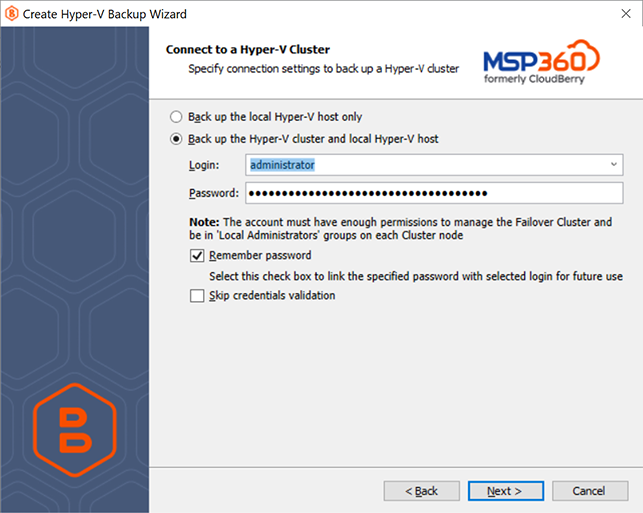
- Select Back up the Hyper-V cluster and local Hyper-V host or Back up the local Hyper-V host only. Consider the Back up the local Hyper-V host only option is intended for virtual machines of the Hyper-V server backup. It is not recommended to use this option in case you want to back up the Hyper-V failover cluster.
- Provide administrative account credentials with Hyper-V role enabled and check whether you want to keep this password in the backup plan configuration.
- Select Remember password to keep the specified password for future use.
- Select Skip credentials validation in case you have no doubts in the provided credentials. Credential validation takes a while.
| Previous Step | Top | Next Step |
Select Virtual Machines (Optional)
In case you are planning to back up specified virtual machines, select virtual machines for the backup plan.
The following options are available:
- Back up all Virtual Machines. Select this option to include all virtual machines of the Hyper-V cluster in the backup plan
- Back up only running Virtual Machines
- Back up selected Virtual Machines.
Consider that clustered virtual machines are marked by specific icons.
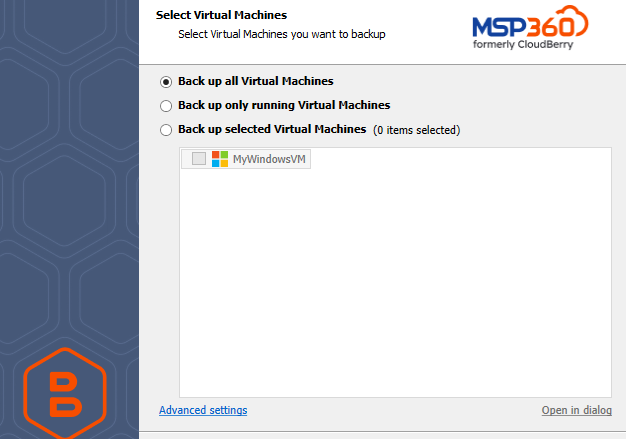
As of version 7.4, you can customize checkpoints to back up. To configure the checkpoint backup, click Advanced Settings. Select Back up current Hyper-V checkpoint only check box to back up the latest checkpoint only. Otherwise all existing checkpoints for the selected virtual machines will be backed up.
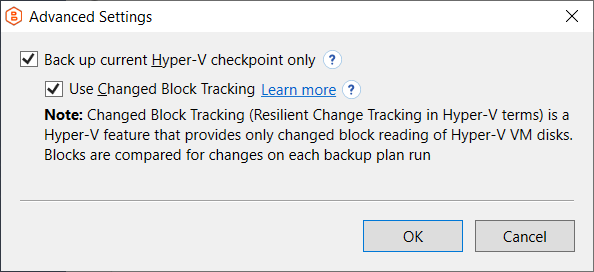
Along with the Back up current Hyper-V checkpoint only option, you can enable the Changed Block Tracking (Resilient Change Tracking) feature. Read more about the Changed Block Tracking in the Changed Block Tracking for Hyper-V paragraph.
Note that if you switch the backup option from the Back up selected Virtual Machines to any other, the previously made selection is kept for the case if you change your mind and select back the Back up selected Virtual Machines option, but the selected option will be applied regardless of the virtual machine selection
Click Next.
| Previous Step | Top | [Next Step]/cloudberry-backup/backup/hyper-v-vm-cluster-backup/hyper-v-cluster-backup-nbf(#5) |
Configure Application-Consistent Backups
You can configure the application processing settings on the Select Virtual Machines step of the Hyper-V backup wizard.

By default, the Try application processing setting is set. Click on the setting to change it, if necessary.
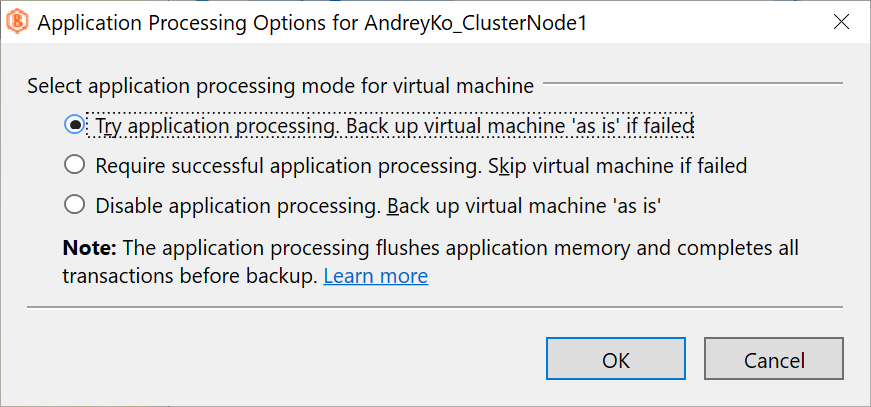
The following options are available:
- Try application processing. Back up virtual machines 'as is' if failed. Once this option is selected, virtual machines are backed up one by one. Using the installed VMware Tools, the state of applications running on virtual machines is checked, then a snapshot is made and an application-consistent backup is performed. In case an application-consistent snapshot is not made for some reason, a regular snapshot is done for this virtual machine.
- Require successful application processing. Skip virtual machines if failed. Once this option is selected, virtual machines with applications that did not flush pending I/O operations from memory to disks, are skipped and an appropriate warning is displayed for a user.
- Disable application processing. Back up virtual machines 'as is'. Once this option is selected, regular VM snapshots are done without quiescing.
Click Next.
Select Virtual Disks (Optional)
In case you selected the Back up selected Virtual Machines option on the previous step, you can select disks on these machines.
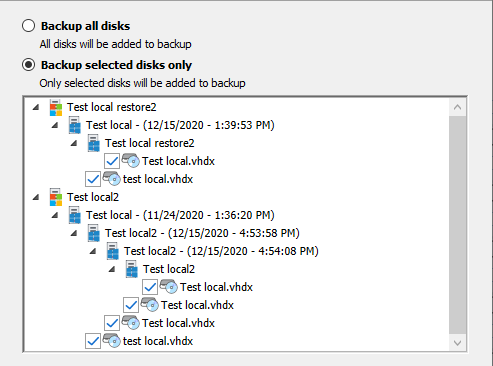
- To back up all virtual machine disks, select the Back up all disks option.
- To select particular VM disks for the backup plan, select the Back up selected disks only option. Use the tree to expand or collapse virtual machine disks or volumes.
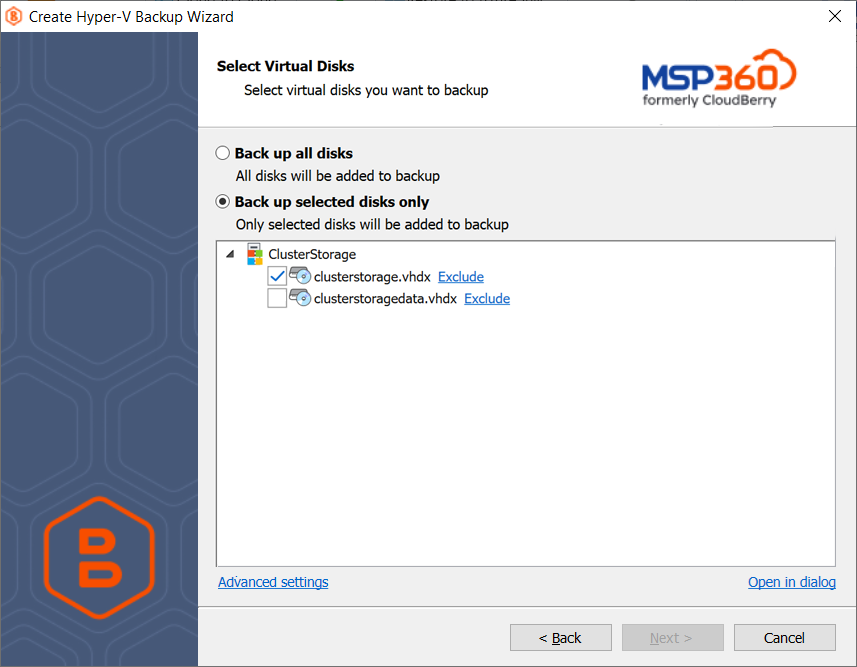
You can expand selected NTFS disks to exclude some objects. Non-NTFS disks can only be included or excluded as a whole.
Click Next.
| Previous Step | Top | Next Step |
Compression and Encryption Options
MSP360 (CloudBerry) Backup offers compression to reduce the storage space required for your backup and to speed up the upload process to the target storage.
Compression
MSP360 (CloudBerry) Backup offers compression to reduce the storage space required for your backup and to speed up the upload process to the target storage.

Encryption
You can protect your backup by encrypting its contents. MSP360 (CloudBerry) Backup supports AES encryption with key sizes of 128, 192, and 256 bits. A larger key size provides stronger encryption but may increase the time required for processing your backup. For more details on AES encryption, refer to the Advanced Encryption Standard.
If you choose to save your backup plan configuration to the destination storage, be aware that the encryption password is not stored in the configuration file for security reasons. Ensure that you save this password securely, as it will be required to restore the backup's contents.
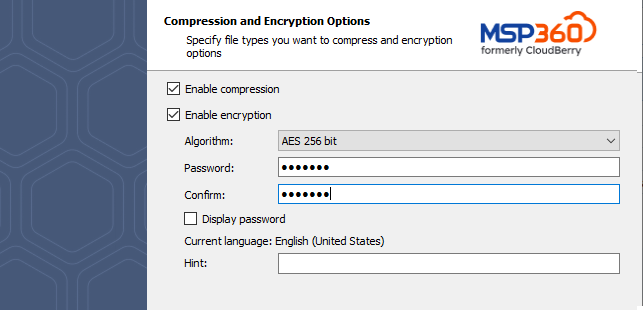
If you change any encryption settings (algorithm or password) for an existing backup plan, a full backup will be executed the next time the backup plan runs.
Click Next to proceed.
Amazon S3-Specific Settings
Server-side encryption is now enabled by default on the backup storage.
If you are using Amazon S3 as your destination storage, the backup wizard provides additional options for encrypting data stored on Amazon cloud servers.
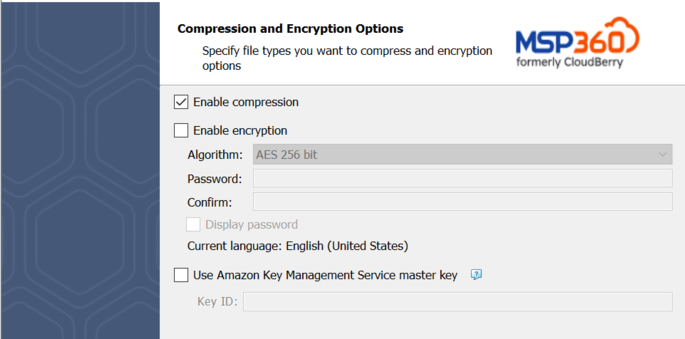
The following additional settings are available when using Amazon S3 for storing your backup:
- Use the Amazon key Management Service master key. Selecting this option allows Amazon S3 to decrypt data for users with permissions to access the object in the cloud and use the specified master key.
See What is AWS Key Management Service for more information.
| [Previous Step]/cloudberry-backup/backup/hyper-v-vm-cluster-backup/hyper-v-cluster-backup-nbf#5) | Top | Next Step |
Consistency Check
Specify the full consistency check and restore verification options.
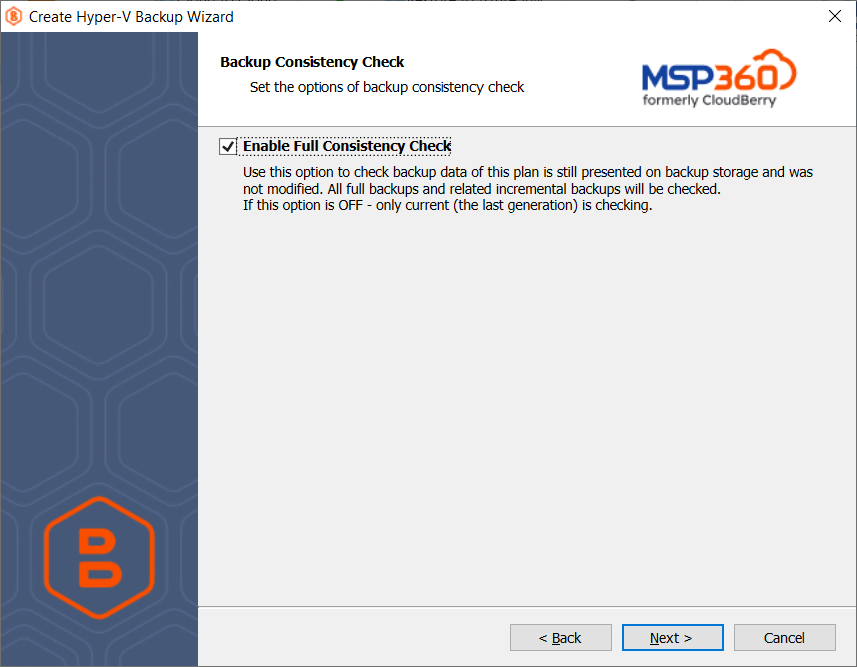
To learn more about consistency checks, refer to the Consistency Checks chapter
Select the restore verification running options:
- Do not Run Restore Verification. Select this option to run restore verification manually
- Run for Full only. Select this option to run restore verification for full backups only. You can manage a schedule for full and incremental backups on the Schedule step of the Backup Wizard
- Run for Incremental only. Select this option to run restore verification for incremental backups only. You can manage a schedule for full and incremental backups on the Schedule step of the Backup Wizard
- Run for Full and Incremental. Select this option to run restore verification for both backup types.
To learn more about restore verification, refer to the Restore Verification for Image-Based Backup chapter
Click Next.
| Previous Step | Top | Next Step |
Schedule
Specify the backup plan schedule settings.
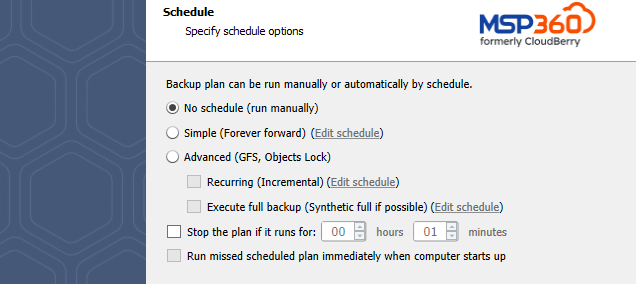
The following options are available:
- Select the No schedule option to run the backup plan manually.
- Select the Simple (Forever Forward) option to apply the Forever Forward Incremental (FFI) schedule.
- Select the **Advanced (GFS, Object Lock) option to apply the recurring schedule and, if necessary, use Grandfather-Father-Son and Object Lock (Immutability).
- To set the time limit for plan execution, select the Stop the plan if it runs for checkbox, then specify the backup plan duration limit.
- To run the backup plan after the computer is on in case the backup plan run has been missed, select the Run missed scheduled backup immediately when computer starts up checkbox.
Click Next.
Simple Schedule
Select the Simple (Forever Forward) option to use the Forever Forward Incremental (FFI). This schedule offers one full backup followed by a limited number of incrementals. Once the limit is exceeded, a new full backup is created using in-cloud copying (synthetic full backup). Once you select this option, specify the FFI schedule for the backup plan. You can select the Daily or Monthly schedule type, depending on how often the incremental backups will be performed.
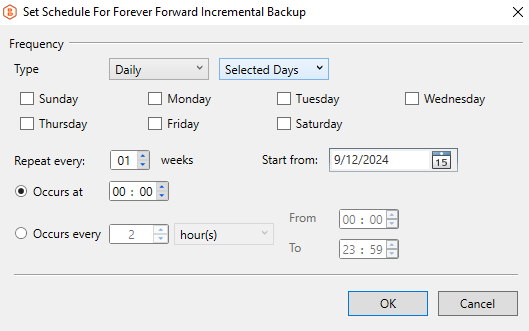
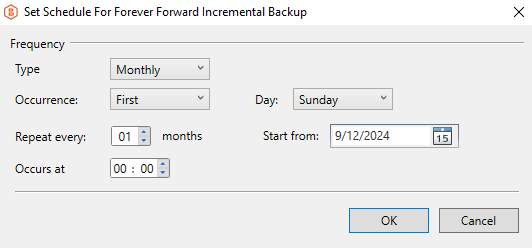
This schedule is unavailable if the selected storage account does not support synthetic full backups.
Advanced Schedule
Select the Advanced (GFS, Object Lock) option to set up a flexible, recurring schedule with generations. Every generation contains one full backup followed by incrementals.
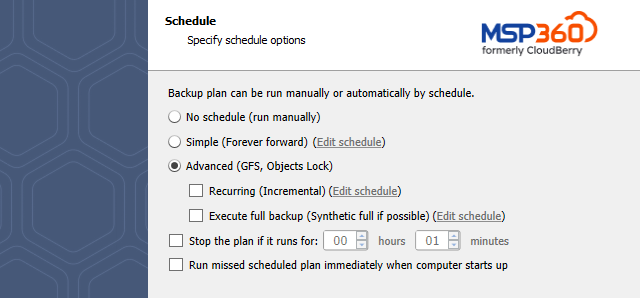
The advanced schedule allows configuring a flexible schedule according to your requirements. To use this schedule you shoud add schedules for full and incremental backup runs:
- To create incremental backups by schedule, select the Recurring (Incremental) checkbox, then configure the schedule for incremental backups on a daily or monthly basis.
- To create full backups by schedule, select the Execute full backup (Synthetic full if possible) checkbox, then configure the schedule for full backups on a daily or monthly basis.
It is recommended to schedule full backup at least once every 3 months for selected schedule
| Top |
Retention Policy, GFS and Object Lock
Specify the retention policy settings for the backup plan. The retention policy depends on the schedule selected on the previous step.
Retention Policy with Simple Schedule
If you selected the Simple (Forever Forward Incremental) schedule, the Retention Policy step offers the following settings:
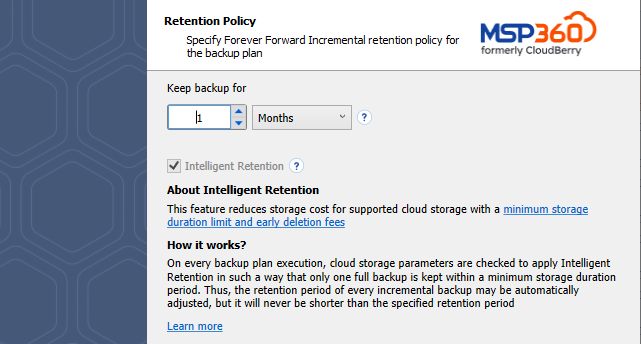
- Keep backup for. Select this option to limit the number of restore points. The Keep backup for value defines the period Restore Points with the Forever Forward Incremental schedule are kept. If their retention period expires, these restore points are merged into a full backup (with Forever Forward Incremental only one full backup is kept on the backup storage).
For backup storages with a minimum storage duration limit and early deletion fees, this value can be exceeded to avoid the fees
- Intelligent Retention: Each time the backup plan is executed, the backup storage parameters are analyzed automatically, setting the retention period based on storage provider data deletion conditions. This feature is enabled by default.
Learn more about the retention policy in the Retention Policy chapter chapter
Retention Policy with Advanced Schedule / No Schedule
If you selected the Advanced (GFS, Object Lock) schedule or to run backup manually without the schedule, the Retention Policy step offers the following settings:
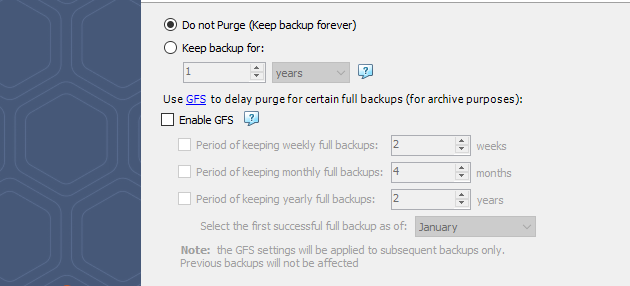
- Do not purge (Keep backup forever). Select this option to keep all your backup runs.
- Keep backup for. Select this option to limit the period while backup contents are kept in the backup storage, then specify the period.
Learn more about the retention policy in the Retention Policy chapter chapter
To apply the GFS retention policy for the backup plan, select the Enable GFS checkbox, then customize the GFS retention policy by enabling the required keeping periods (weekly, monthly and yearly purge delays).
To learn more about the GFS retention policy, refer to the About GFS chapter
If backup data is required to be locked, enable the Object Lock (Immutability) checkbox.
To learn more about the Object Lock (Immutability) feature, refer to the Object Lock (Immutability) chapter
Click Next.
| Top |
Pre / Post Actions
Customize actions before and/or after the backup plan run.

Custom Scripts
You can execute custom scripts before or after running the backup plan.
To specify the script execution before the backup plan starts, select the Pre-backup action checkbox, then specify the path to the script in the field below. To open a standard Windows dialog box, click the ... button
Select the pre-backup script execution options:
- Do not run the backup plan if the pre-backup action fails. Select this option to cancel the backup plan in case the specified script fails
- Run the backup plan if the pre-backup action fails. Select this option to run the backup plan regardless of the specified script execution results
To specify the script execution after the backup plan terminates, select the Post-backup action checkbox, then specify the path to the script in the field below. To open a standard Windows dialog box, click the ... button
Select the post-backup script execution options:
- Execute post-backup action only if the backup plan completes successfully. Select this option to execute the post-backup script only in case of a backup plan success
- Execute post-backup action regardless of the backup plan result. Select this option to execute the post-backup script in any case.
Note that an absolute path to a script is required, i.e. if you specify the path to a script, it should be as follows:
c:\scripts\prebackup-script.bat
In case the absolute path to a script file is not specified, the default directory for the script is "C:\Windows\System32"
The following script formats are supported: EXE, COM, BAT, CMD, or PIF
Mind that MSP360 (CloudBerry) Backup supports EXE files have several restrictions: EXE files must not use GUI and must close automatically upon termination.
For example, the following script will not succeed:
cmd.exe /F:ON
In this case, this command must be used with the /C parameter, as shown below:
cmd.exe /F:ON /C
The same restriction applies to applications executed by PowerShell scripts:
PowerShell.exe Start-Process cmd.exe exit
It is highly recommended to perform a test run for the created backup plan to ensure that MSP360 (CloudBerry) Backup properly executes specified scripts
Backup Plan Chains
In case you need to run another backup or restore plan once the backup plan is finished, use the Backup Chain feature. To create a backup chain, select the Backup chain checkbox, then select a backup or restore plan to be chained.
- Run the selected plan if the backup plan completes with success. Select this option to execute the chained backup plan only in case of a backup plan success
- Run the selected plan regardless of the backup result. Select this option to execute the chained backup plan in any case
Select the run mode for the chained plan:
- In case you chained a backup plan, you can enable the full backup for it regardless of the contents in the backup storage. To do this, select the Force full backup for the chained plan.
- Select Use settings of the current plan to run the chained plan as full if this plan has the scheduled full backup run or as incremental if this plan has the scheduled incremental backup run.
To learn more about the full backup type, refer to the Full Backup Explained chapter
Click Next.
| Top |
Notifications and Logging
Specify notification and logging settings.
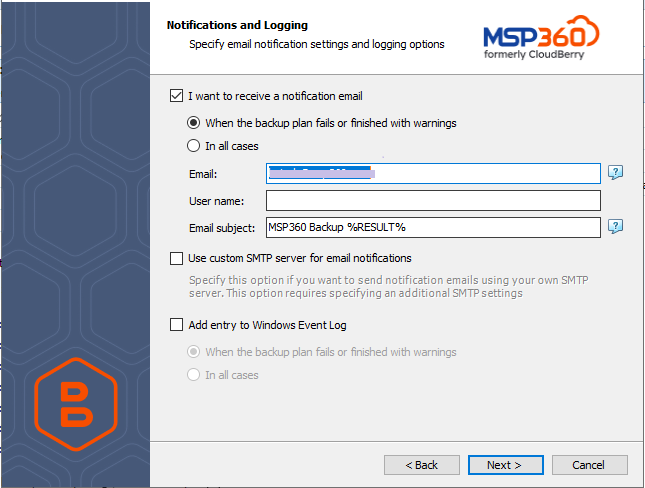
- To receive the notification after the backup plan completion, select I want to receive notification email check box.
- Select When backup fails or finished with warnings option if you want to receive the notification message in case of the backup plan failure or in case of some warnings
- Select In all cases option if you want to receive the notification message in any case.
- In the fields Email, Use name, Email subject specify the notification email details. You can specify one or more email recipients. Separate them by semicolon or comma, the recipient name (one for all of them). The email subject that can also contain any of the following variables:
- %COMPUTER_NAME%. Displays the instance name on which the backup plan was executed
- %RESULT%. Displays the result of the backup plan. Possible values: Success, Finished with warnings, Failed
- %PLAN_NAME%. Displays the name of the backup plan.
- If you want to use own SMPT server for notification emails, select the Use custom SMTP server for email notifications check box, then specify the settings for the SMTP server
- If you want the backup plan record to be added to Windows Event Log, select on Add entry to Windows Event Log when backup completes check box
- Select When backup fails or finished with warnings option if you want to receive the notification message in case of the backup plan failure or in case of some warnings
- Select In all cases option if you want the entry to be put in Windows Event Log in any case.
Click Next.
Summary
Review the configuration of the backup plan.
Click Next to proceed to the last wizard page.
Select the Run backup now checkbox to run the backup plan immediately.
If you want to run the backup plan later, leave the Run backup now checkbox cleared, then click Finish.
| Top |
Edit a Backup Plan
To edit the backup plan, proceed as follows:
- Switch to the Backup Plans tab.
- Open the backup plan you want to edit by expanding it, then click Edit.

- Proceed through the Backup Wizard steps to adjust settings as needed.
- If the plan is currently running, you'll need to select one of the following options:
- Apply changes after the backup plan completes
- Stop the plan and apply changes.
- After choosing the desired option for the running backup plan, click Apply.
- Save the edited plan configuration.
You can edit certain backup plan parameters directly, without using the backup wizard, as long as the backup plan is not currently running. Editable parameters are marked with a pencil icon. To make a quick edit, simply click the pencil icon next to the parameter
Delete a Backup Plan
To delete the backup plan, proceed as follows:
- Switch to the Backup Plans tab.
- Open the plan to delete, expand it, then click Delete.
- Confirm the backup plan deletion.